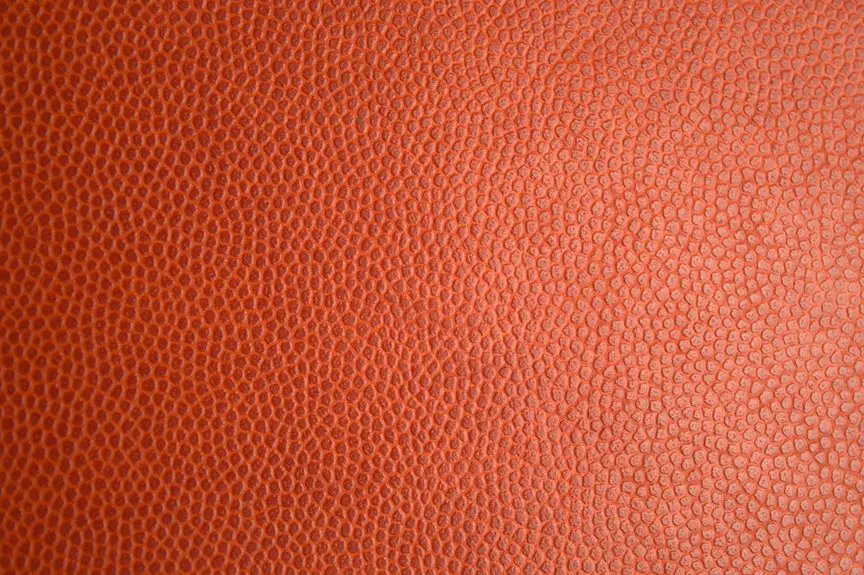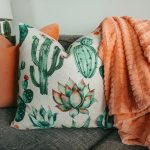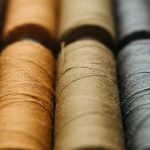If you want upholstery that’s durable, stain-resistant, and easy to maintain, polypropylene fabric is a smart choice. It holds color well, resists moisture, and stands up to everyday wear, making it great for busy spaces. However, it’s less breathable, can attract static, and may pill over time. It works well both indoors and outdoors, especially in high-traffic or humid areas. Keep exploring to uncover how it compares with other fabrics and best care tips.
Table of Contents
Key Takeaways
- Polypropylene fabric is durable, moisture-resistant, and holds color well, making it great for upholstery in high-traffic and outdoor areas.
- It offers excellent stain resistance and is easy to clean with mild soap and water, requiring low maintenance over time.
- The fabric resists wear and tear but can pill, and it is less breathable than natural fibers, potentially causing discomfort in warm climates.
- Polypropylene is cost-effective and withstands sunlight better than many fabrics but may fade with prolonged UV exposure.
- It attracts static electricity, which can collect dust and pet hair, necessitating more frequent cleaning compared to natural fibers.
What Is Polypropylene Fabric?
Polypropylene fabric is a synthetic material made from polymer fibers known for their durability and resistance to moisture. When you choose polypropylene, you’re picking a fabric that stands up well to wear and tear, making it a practical choice for various uses.
This material is lightweight yet strong, which means it can handle everyday use without losing its shape or strength. You’ll find polypropylene commonly used not only in upholstery but also in outdoor gear, carpets, and reusable bags.
Its moisture-resistant nature helps prevent mold and mildew, so it’s great for spaces where dampness is a concern. Plus, polypropylene is easy to clean, which means maintaining your furniture won’t be a hassle.
Key Characteristics of Polypropylene Upholstery
You’ll find that polypropylene upholstery stands out for its impressive durability and strength, making it ideal for everyday use.
It holds color well, so your furniture won’t fade quickly even with plenty of sunlight.
Plus, it’s naturally resistant to stains, which helps keep your upholstery looking fresh longer.
Durability and Strength
Longevity matters when choosing upholstery fabric, and this material excels in that regard.
Polypropylene stands out because it resists wear and tear better than many other fabrics, making it ideal for high-traffic areas. You’ll appreciate its strong fibers that hold up well under frequent use, reducing the chances of fraying or pilling.
This fabric also resists stretching and sagging, so your furniture keeps its shape over time. Plus, it’s inherently resistant to moisture and stains, which helps maintain its integrity longer.
While it’s lightweight, don’t underestimate its toughness — polypropylene delivers impressive strength without feeling heavy or stiff.
When durability and strength are your priorities, this fabric offers reliable performance that won’t disappoint.
Color Retention and Fading
Although upholstery fabric often faces constant exposure to sunlight and everyday wear, this material holds its color remarkably well.
When you choose polypropylene for your furniture, you’ll notice it resists fading better than many other fabrics. Its synthetic fibers are designed to withstand UV rays, meaning your colors stay vibrant even in bright rooms or sunlit patios.
However, while polypropylene is strong in color retention, prolonged exposure to intense sunlight can eventually cause some fading. To keep your upholstery looking fresh, consider placing it away from direct sunlight when possible.
Resistance to Stains
Because spills and stains are inevitable in everyday living, choosing upholstery that resists them can save you time and effort. Polypropylene fabric excels here—it naturally repels many liquids and is easy to clean. You won’t have to stress about accidental coffee spills or pet messes ruining your furniture. However, it’s not completely stain-proof, so prompt cleaning is still key.
| Spill Type | Polypropylene Response | Your Benefit |
|---|---|---|
| Coffee | Repels, easy wipe-off | Quick cleanup, no lasting marks |
| Wine | Resists penetration | Low stain risk |
| Pet Accidents | Resists absorption, odorless | Less damage, fresher furniture |
| Ink | Can stain if not cleaned fast | Act fast to maintain fabric look |
Advantages of Using Polypropylene for Upholstery
When you choose polypropylene for upholstery, you get a fabric known for its durability and strength.
It resists stains and water, making spills easy to handle.
Plus, it’s cost-effective and simple to maintain, saving you time and money.
Durability and Strength
If you want upholstery that stands up to daily wear and tear, polypropylene fabric delivers exceptional durability and strength. This synthetic material resists abrasion better than many natural fabrics, so your furniture stays looking fresh even with frequent use.
Polypropylene fibers have high tensile strength, meaning they won’t easily stretch or tear under pressure. You’ll appreciate how this fabric holds its shape over time, avoiding sagging or pilling.
Plus, it withstands exposure to sunlight without degrading quickly, making it ideal for rooms with lots of natural light. When you choose polypropylene, you get upholstery designed to endure the demands of everyday life, maintaining its structural integrity and appearance long-term without the need for constant repairs or replacement.
Stain and Water Resistance
Although spills and stains are inevitable, polypropylene fabric makes cleaning up much easier and less stressful. This material naturally resists water and most stains, so liquids bead up instead of soaking in.
When something spills, you can quickly wipe it away without worrying about permanent marks. Polypropylene’s stain resistance comes from its non-porous fibers, which don’t absorb moisture or dirt easily.
This means you don’t have to scrub hard or use harsh chemicals to maintain your upholstery’s appearance. Plus, it’s less likely to hold onto odors caused by spills.
If you want furniture that stays looking fresh and clean with minimal effort, polypropylene’s stain and water resistance is a major advantage to take into account for your upholstery needs.
Cost-Effectiveness and Maintenance
Since polypropylene fabric combines durability with low maintenance, it offers excellent cost-effectiveness for upholstery.
You’ll save money over time because it resists wear and tear better than many alternatives. Plus, cleaning it’s quick and simple, cutting down on costly professional treatments.
Here’s why polypropylene is a smart choice for your budget and upkeep:
- Affordable initial cost compared to natural fibers
- Resistant to stains and fading, reducing replacement needs
- Easy to clean with just mild soap and water
- Low likelihood of damage from everyday spills and dirt
Common Drawbacks of Polypropylene Fabric
While polypropylene fabric offers many benefits, you should be aware of its common drawbacks before choosing it for upholstery.
One key issue is its susceptibility to pilling, which can make your furniture look worn out quicker. You might also find that polypropylene isn’t as breathable as natural fibers, so it can feel less comfortable, especially in warm climates.
Additionally, it can be prone to static electricity, attracting dust and pet hair, meaning you’ll need to clean more often.
Another downside is its lower resistance to heat and UV rays, which may cause fading or damage over time if exposed to sunlight.
Being aware of these drawbacks helps you weigh whether polypropylene fits your needs or if another fabric might serve you better.
How Polypropylene Performs in Different Environments
When you select polypropylene upholstery fabric, understanding how it performs in various environments can help you make the best choice for your space. This fabric adapts well but has specific strengths and limitations depending on where you use it.
- Outdoor Settings: Polypropylene resists moisture and mildew, making it ideal for patios or sunrooms.
- High Humidity: It handles humid conditions without developing mold, perfect for bathrooms or kitchens.
- Hot Climates: The fabric tolerates heat but may fade if exposed to direct sunlight for extended periods.
- Indoor Use: It’s stain-resistant and durable, suitable for living rooms or offices with moderate traffic.
Knowing these factors lets you pick polypropylene that suits your environment perfectly.
Maintenance Tips for Polypropylene Upholstery
Although polypropylene upholstery is known for its durability and stain resistance, you’ll want to follow some simple maintenance tips to keep it looking fresh and extend its lifespan.
Regular vacuuming helps remove dust and debris that can wear down fibers over time. For spills, blot immediately with a clean cloth—avoid rubbing, which can push stains deeper.
Use mild soap and water for cleaning; harsh chemicals can damage the fabric. Test any cleaner on a hidden area first to verify it won’t discolor.
Avoid prolonged exposure to direct sunlight to prevent fading. Rotate cushions periodically to guarantee even wear.
Comparing Polypropylene With Other Upholstery Fabrics
Since choosing the right upholstery fabric affects both style and durability, you’ll want to understand how polypropylene stacks up against other common options like cotton, leather, and polyester.
Here’s a quick comparison to help you decide:
- Durability: Polypropylene resists stains and fading better than cotton but isn’t as durable as leather.
- Maintenance: It’s easier to clean than cotton and leather, similar to polyester’s low-maintenance nature.
- Comfort: Polypropylene feels less breathable than cotton, but it’s softer than some polyester blends.
- Cost: Usually, polypropylene is more affordable than leather and some high-end polyesters, making it budget-friendly.
Ideal Uses and Applications for Polypropylene Upholstery
Polypropylene upholstery fits perfectly in spaces where durability and easy maintenance matter most. You’ll find it ideal for high-traffic areas like family rooms, kids’ playrooms, and commercial settings. Its stain resistance and quick-drying nature make it a top choice for outdoor furniture and casual seating. When selecting upholstery, consider where spills, wear, and sun exposure happen often—polypropylene handles these challenges well.
| Use Case | Benefits | Why It Works for You |
|---|---|---|
| Outdoor Furniture | UV resistant, water repellent | Stays fresh despite weather |
| Kids’ Playroom | Stain-resistant, durable | Handles spills and rough use |
| Commercial Seating | Easy to clean, tough fabric | Withstands heavy daily wear |
| Casual Living Room | Comfortable, low upkeep | Perfect for relaxed, busy homes |
| Pet Areas | Resistant to odors and stains | Keeps furniture looking new |
Frequently Asked Questions
Can Polypropylene Fabric Be Recycled After Use?
You can recycle polypropylene fabric after use, but it depends on local facilities. It’s a thermoplastic, so it melts down easily. Check your area’s recycling guidelines to verify it’s accepted and processed properly.
Is Polypropylene Upholstery Fabric Hypoallergenic?
Did you know 60% of allergy sufferers find relief with hypoallergenic materials? Polypropylene upholstery fabric resists dust mites and mold, so you’ll reduce allergens in your space, making it a smart choice if you have sensitivities.
Does Polypropylene Fabric Emit Any Odors When New?
You might notice a slight chemical odor when polypropylene fabric is new, but it usually fades quickly with good ventilation. Don’t worry; the smell isn’t strong or harmful, so airing it out helps a lot.
How Environmentally Friendly Is Polypropylene Production?
Imagine a factory puffing out plastic clouds—polypropylene’s production still relies on fossil fuels, so it’s not the greenest. You’ll want to weigh its energy use and waste when judging its environmental friendliness.
Can Polypropylene Upholstery Be Dyed at Home?
You can’t easily dye polypropylene upholstery at home because it’s resistant to most dyes. You’d need special solvents or professional services. So, if you want to change its color, consider other fabric options instead.
- What Is Pochampally Ikat? a Journey to India’s Silk City - June 27, 2025
- What Is Pochampally Ikat? a Journey to India’s Silk City - June 27, 2025
- What Is Pochampally Ikat? a Journey to India’s Silk City - June 27, 2025







